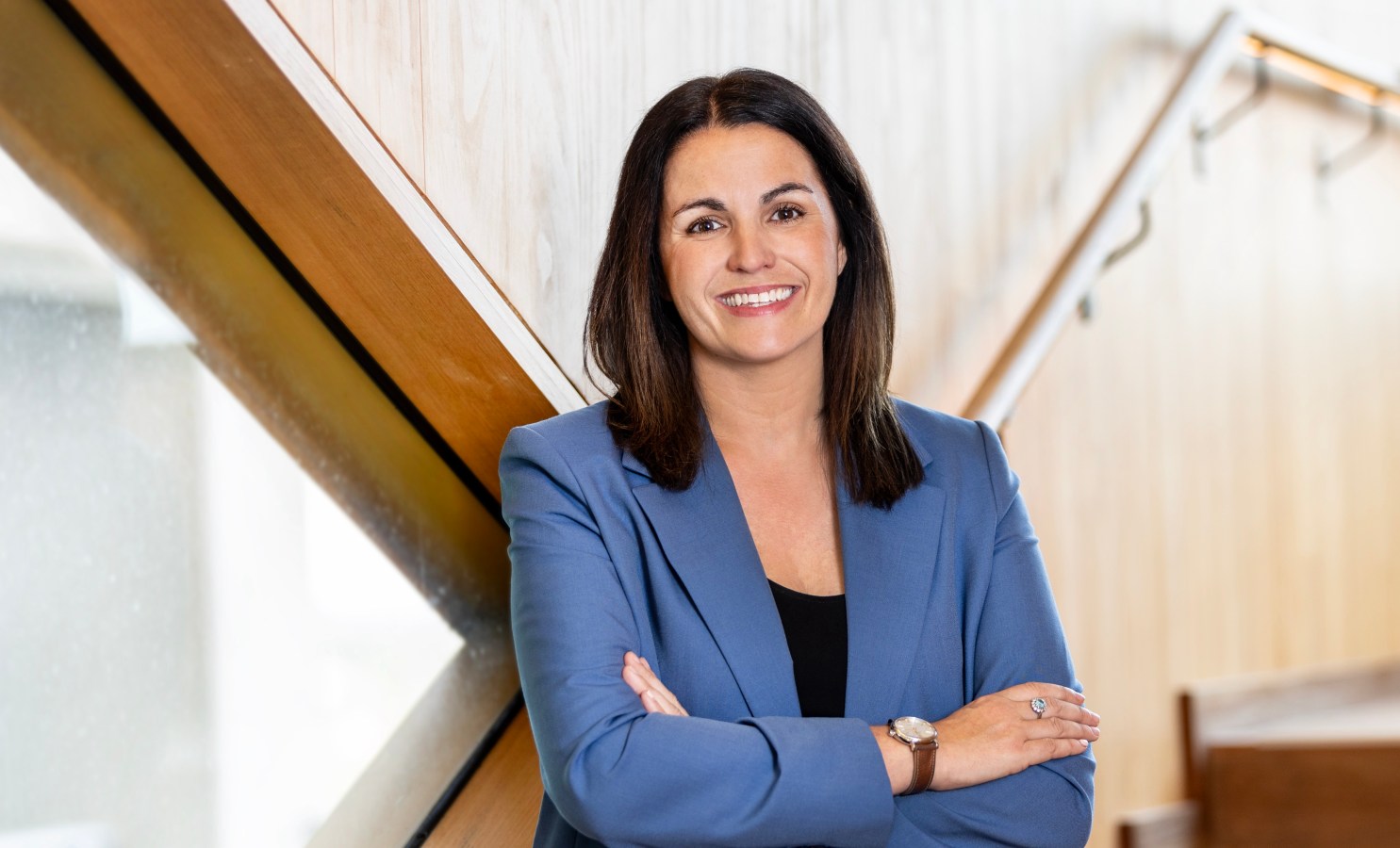Interface.ai cofounder Srinivas Njay built a powerful virtual financial assistant with just $1 million in capital. The VCs are lining up—but like many self-funded entrepreneurs, he doesn’t need them.

For five years, founders Srinivas Njay and Bruce Kim have been building interface.ai and its artificial intelligence powered virtual assistant that helps banking customers do everything from analyze their spending to fill out a mortgage application to open a new credit card. So far, they’ve signed up more than 100 credit unions and small community banks serving 16 million consumers—contracts worth tens of millions in annual revenue.
With AI in his company name and product, CEO Njay has been fielding a stream of calls from venture capitalists—more than 40 over the past several months, he estimates. He’s happy to talk, he says, because at some point, the right investor might help scale up growth. “I’m just dating,’’ Njay says. “We are in a good place, it’s not like we need money.’’ That’s because Njay, 37, and CIO Kim, 59, have been able to get their company to this point with just $1 million of their own savings, a $3 million credit line from TMCC, an Indian credit union run by Njay’s father, careful cash and expense management—and crucially—internally generated revenue.
It’s the classic entrepreneurial formula. Just 0.5% of start-ups with employees receive venture capital investment to get rolling, while 65% use founders’ own savings, 17% tap bank loans and 9% rely on money from relatives, according to the Kaufman Foundation. From there, they bootstrap growth using revenue coming in.
Yet despite such numbers, in recent years fast growth has become popularly associated with VC backing as startups in some sectors—financial technology being a prime example—have become addicted to VC funds. Now, as funding and private company valuations contract, a good number of VC-backed startups are laying off workers and scrambling to conserve cash, while successful penny-pinching bootstrappers are getting some well-deserved respect.
Njay and Kim are hardly an overnight success story. After meeting and joining forces in 2015, they spent four years building financial bots to assist with bill payments and money transfers for the Indian market (back then, the business was called Payjo) before concluding the U.S. market had more potential. Today, 130 of San Jose-based interface.ai’s 170 employees are in India, which keeps payroll costs low and productivity high, since the time difference means engineers can work on problems around the clock. “Without a combination India-US team, I don’t think we could have bootstrapped the business,” says Njay, who earned his bachelor’s in computer science at SIT in Bangalore and master’s at Northeastern, before doing a couple years each at Microsoft and Electronic Arts.

To crack the U.S. market, interface.ai has zeroed in on a niche sales approach that requires little spending on marketing—one of the areas where consumer-facing fintechs have burned through sacks of VC cash. The strategy: focus on serving only financial institutions too small to develop their own AI or to demand extensive customization. “That’s where we see a cookie cutter model where there is a product you can build and sell many times,” Njay says. Customer acquisition costs have been held down further by two partnerships—one struck in 2022 with a subsidiary of the credit unions’ trade association (then CUNA, now America’s Credit Unions) and one in 2021 with Allied Solutions, an insurance broker selling to small banks and credit unions. The deals give Interface.ai access to 95% of its target market, in return for a small commission.
Njay’s pitch to prospective customers: AI can drive down costs and make them more competitive with the big guys. External events have helped him make the sale; the need for more automation became painfully obvious to credit unions during the pandemic, when their call centers were deluged, and then when labor shortages emerged. The latest suite of tools interface.ai rolled out last year guides customers both online and via telephone, and integrates with a tool for employees, so if a call does get handed off to a human, they’ll have all the information. New bells and whistles do things like generating a video response for bank customers instead of sending them a long block of text.
“We are at the right place at the right time. With generative AI, we’ve been doing this for five years,’’ Njay says. “It was not a goal to avoid raising capital. It happened that early on in the pandemic we grew super fast and never had enough time to run a really good process. We’ve been extremely busy building the company, taking care of our customers and since we started making money, raising was not a priority.” Ultimately, he says, he’s not against outside capital—but only if it comes with a board member who brings experience scaling a company and has strong knowledge of what’s going on in AI, including in the apps layer, where his company operates.
It is not just fintech, of course. Other industries—such as direct to consumer ecommerce—have already gone through the process of discovering that the winners aren’t always those with investors throwing money at them before they even have any sales. “People are finally converting to the religion of profitability,” crows Mike Salguero, who launched meat delivery service ButcherBox in 2015 with $10,000 of savings and a kickstarter campaign offering pre-sales of his premium cuts. While food box services with big VC dollars behind them have struggled, ButcherBox has been profitable since its first year. “The constraints of not raising capital is actually the thing that has kept our business going and has kept us focused on the right metrics, on the right projects and on the right marketing,’’ he says.
U.S. venture firms raised just $67 billion in 2023, the lowest haul since 2017 and down 61% from 2022. Yes, the VCs are still chasing deals in AI and have plenty of uncommitted funds. But the continued weakness in the market for initial public offerings since 2021’s record (and poor-performing) crop, is dragging down private market valuations in some segments and limiting what VCs consider worth funding.
“We have these factory-farmed unicorns that were supposed to be worth a few billion dollars in a public market and everyone built to that spec rather than building authentically good businesses. It turns out that doesn’t work,” says Sam Lessin, a general partner at Slow Ventures. “The public market doesn’t want factory farm unicorns. They’re not the same thing as the USDA prime organic.” He emphasizes that a broad range of businesses, built slowly, can ultimately take off–with or without VC money. “In the era we live in today, the idea that you build a good business on the way to a great business is no longer foreign,” Lessin says. “Things that seem kind of small at first can be absolutely enormous because the world is huge and with cloud computing, global internet, et cetera, things that even seem niche can reach massive scale.”’
Higher interest rates—the Federal Reserve started raising rates in March 2022—have clearly changed the calculus for private investors. “Venture capitalists need to get money from somewhere and those people have expectations on the multiples of their money, otherwise they would just put it in T-bills and earn 5%” says Jenny Fielding, cofounder and managing partner of Everywhere Ventures, a seed stage venture firm.
Recently, startups have been getting some freighted messages from their backers, Fielding notes. “The subtext of any investor saying ‘get to profitability or breakeven’ or ‘control your destiny,’ all those things basically mean, ‘well, you might’ve started off with venture, but we don’t really see that as the path for you anymore.’” In other words, you may have started with our money, but you’ll need to bootstrap now.

Interface.ai cofounders Srinivas Njay (left) and Bruce Kim (right).
Cody Pickens for Forbes
That’s been the approach that Gateway X has taken since its founding three years ago as a self-described “venture studio.” It comes up with promising business ideas, puts together a team of entrepreneurs and provides them with $500,000 or less in startup capital, expecting them to bootstrap from there. One startup, for example, is a platform that helps marketing teams find overseas workers to help roll out campaigns. “We call the model that we use ‘bootstrapped giants,’ which is a business that we want to get profitable in the first year and then grow it profitably for the long haul,’’’ says Gateway X CEO and founder Jesse Pujji, who founded and sold his own bootstrapped startup, digital marketing firm Ampush. “We’re ambitious, but we don’t subscribe to the venture funded approach” with multiple, ever larger, funding rounds.
Bootstrapping, particularly in an industry like fintech where competitors have loads of VC cash, can require patience and steely nerves. Just ask Paul Beldham, CEO and majority owner of Rochester, New York-based PayQuicker, a payments platform which enables instant global payouts in 80 currencies for everything from insurance claims, to stipends for participants in clinical trials to affiliate marketing payments to social influencers. Its system uses algorithms to determine the most efficient method in various cases—with money disbursed via prepaid debit cards, virtual cards and mobile wallets.
Beldham, 79, has an unusual—and unusually long—backstory for a fintech entrepreneur. An electrical engineer by training, he sold his first startup, a pumps and equipment manufacturer, to IDEX Corp. in 1998, stayed in that industry for the next decade and then started looking for something new. In 2008 he acquired PayQuicker, which was trying to develop a payments platform for social media. When he realized it would take millions (not the $300,000 he had budgeted) to build that platform, he considered—and rejected—taking VC cash. “I initially talked to venture firms and those conversations showed what is typical in venture. They’re investing. They’re taking a risk, they want a significant piece of the ownership to take that risk, and I just thought it was too expensive to raise capital that way,” he recalls.
Instead, Beldham ended up tapping well-off friends for something north of $5 million, while keeping 100% voting control and bootstrapping from there. “I just found it a much more comfortable way to grow the business, while retaining maximum ownership for myself and some of the key employees who have ownership.”
PayQuicker has been profitable since 2014, but has grown comparatively slowly. “Some would argue that by taking in outside money, we could have grown faster,” Beldham reflects. “I must have watched 20, 30 fintechs in the payout space emerge, and every time I saw one back in 2010, 11, 12, I thought, ‘oh my goodness, somebody’s going to get this right. This is going to be it,’ and then they just went away after a period of time. Certainly some good ones emerged, those are partners of ours today.” (One partner, for example, is Forbes Fintech 50 member Nium, which has raised $288 million and got a $2.1 billion valuation from VCs at the height of the fintech bubble. Nium is hoping to go public next year.)
Beldham acknowledges that if PayQuicker wants to scale, it will have to raise outside capital—a prospect he hasn’t ruled out. He estimates that his company is worth around $200 million–not unreasonable at today’s multiples. “At some point, probably sooner, than later, PayQuicker will be working with a growth equity partner because we see so many opportunities at this point in time that it doesn’t make sense not to take in several million dollars to expand on those opportunities.”
Three days before Black Friday 2018, Mike Beckham woke up to discover that Amazon had inexplicably suspended the business account of his three-year-old company, Simple Modern, which sells sleekly designed water bottles and other utilitarian products. At that point, he was sitting on roughly $2 million-worth of inventory and the mega marketplace accounted for 95% of his sales.
“It was absolutely terrifying,” recalls Beckham, now 44, who had launched his Moore, Oklahoma-based business in 2015 with two cofounders and $200,000 in personal savings. The site was reactivated in time for the post-Thanksgiving rush, but not before Beckman started obsessing over the grim possibilities. “During that period, I’m thinking ‘I can live in a smaller house.’ You’re actually having thoughts like that because your personal assets are at stake.”
Today, Simple Modern is an unvarnished success—it made $40 million in profit on $200 million in 2023 sales, with a presence at Target and Walmart, as well as Amazon. It’s not just that Beckham doesn’t need the money. It’s a matter of autonomy, he says. Without investors demanding payback, he’s free to donate 10% of profits, with last year’s $4 million going to such organizations as clean water focused Water4; Restore OKC, which works to eliminate racial divisions in Oklahoma City; and St. Paul’s Community School, an Oklahoma elementary school that aims to make a Christian education available to poor children.
Says Beckman: “We stayed bootstrapped because we really felt like we weren’t going to be able to run the type of company that we wanted to run if we took outside capital, that the demands of the shareholders or their interests might conflict with some of the things that we wanted to do, especially when it came to giving money away.”
This article was first published on forbes.com and all figures are in USD.


